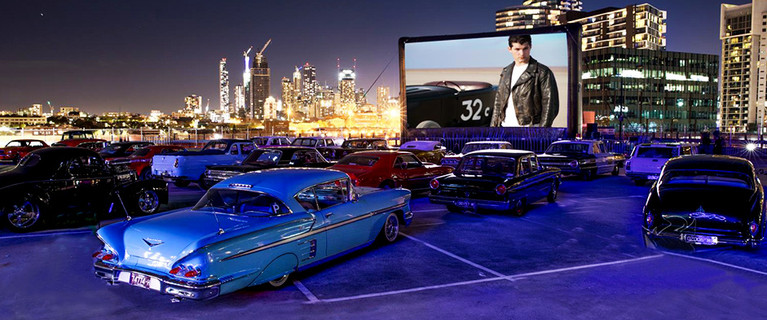
As I get older I like life to be simple. I tend to seek out things which have pure intent. In the world of cinema and cinema exhibition there is nothing purer than the drive-in. The drive-in is movie going at it’s simplest and at its best. If you provide the customer a viewing experience defined primarily by themselves chances are once exposed to the experience will crave it going forward. The key thing about Drive-ins, is that they provide the opportunity to present a flexible and customer centric viewing and concession program that provides value and choice compared to hard top cinemas.
I would make the proposition that drive-ins, in their best execution were, the ideal movie theaters.
Drive-ins were born at a time when the movies were changing greatly, a giant vacuum had been formed and something needed to fill it. As Hollywood’s golden age ended, studio monopolies did too. Simultaneously, audiences in large volumes moved from cities to suburbs. Drive-ins embodied and reflected those changes and created an entirely new way of watching the movies. No longer did audiences have to sit in fancy movie palaces where silence was golden and mandated. At the drive-in, spectators could smoke, eat, talk, and fumble around in the back seats with members of the opposite sex. This hearkened back to older audience practices common during the vaudeville era. Drive-ins, were the amalgamation of old-school fairgrounds, exhibition halls, and nickelodeons all in one distilled attraction. Drive-ins provided their customers with a variety of activities, from new releases movies, great B movies. Along with playgrounds, bingo and even fireworks.
This carnival like atmosphere created a strange combination of both socialization and isolation. Outside of your car, moviegoers could mix and meet new people. Inside their metallic cocoons, they enjoyed privacy and a viewing experience that had more in common with the suburban family room than a traditional movie theater. In many ways the drive-in was the link between movie going and watching television. the in-car movie viewing experience was in many ways a transition to television a transition which damaged and changed the face of modern movie going. The drive-in arose in the midst of the rise of the middle class and coupled with a profound migration away from the cities towards the suburbs.
Drive-ins also brought new moviegoers together, moviegoers that in the past had been defined by race and economic status. In many ways the drive-ins brought into play, a great coming together, a economically accessible and democratically accessible form of entertainment. In the deep South, they were some of the first venues to be integrated. The dirty balconies of Jim Crow theaters became a memory as Afro-American families could now visit a drive-in under their own terms. The drive-ins provided an outlet for families with loud children, comfortable seating for the disabled and a safe haven for the socially awkward.
Drive-ins soon developed a reputation for being passion pits, a venue where moviegoers could exercise the more lascivious parts of their nature.
Drive-ins often struggled with studios, trying to get them to acknowledge them as part of the main stream of the exhibition industry. As much as they protested it, drive-ins are truly a distinct and unique animal unto themselves as opposed to a hard top theater. Everything about them is different. Their booking is different, their environment is vastly different, the concessions are different and frankly management and staffing, although similar to the models in the 50’s are vastly different operationally than the multiplex of today.
Nevertheless, drive-ins were often increasingly punished by the movie studios and often prevented from screening first-run movies. This forced drive-ins to rely on B grade movies, giving rise to the reputation of drive-ins’ being solely a B movie destination. What is interesting is that the B movies would be forever tied to the ideal of a drive-in and often those who crave a genuine drive-in movie experience want to see those days rise again. Filmmakers like Roger Corman, Charles Pierce and Earl Owensby found to their market via the various drive-in circuits, The rising need for suburban real estate encroached on the drive-in and one by one after a zenith of 4000 drive-ins saw their near extinction. Today 352 drive-ins are left in existence.
I missed writing an article last week because I was in the midst of erecting the 352nd drive-in Corpus Christi Texas. It was a frustrating and an exhilarating experience at the same time. I learned some key lessons which re-asserted that drive-ins are indeed unique animals. This is a dive-in movie theater, a sixty foot former destroyer mast supports a 45 foot screen, re-enforced with C channel beams. On an island the winds can shift in a blink of an eye and can blows with fierceness, another lesson learned. Our screen sits in the middle of a lazy river, when the temperatures become warmer audience members shall be able to bob around and float while watching Jaws and or the Titanic. This is experiential viewing at its finest.
We screened a movie, daughters sat on the laps of their fathers while they munched on popcorn. Children with glee, filled cups with bulk candy, a little boy dressed up like the lead character. Most importantly community was being built and experiences formed. At the end of the movie the audience erupted in applause. After all that hard work that was the only pay-off I needed.
Outdoor movie going is coming back with a vengeance. In Europe hundreds of permanent and temporary theaters have been established, Rooftop Cinema, and English invention has planted roots in Houston. For me, the true future of exhibition has always been based in outdoor cinema or alternative venues. An art form as wild and eclectic as cinema should never been constrained within a multiplex.
